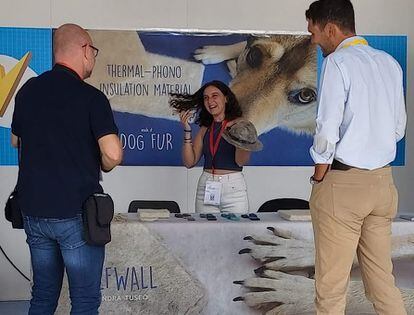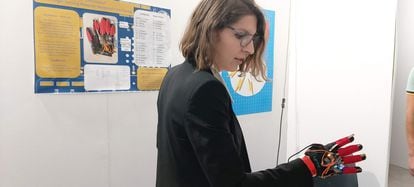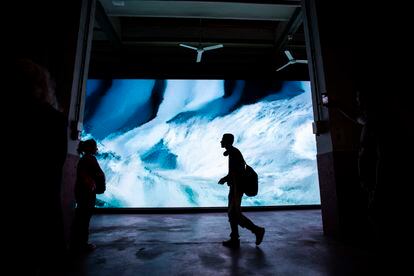Maker Faire Rome: Europe’s Largest Tech Expo Features Dog Hair Insulation and Flying Bike | science and technology
“The world is not binary. You can be a generalist or a specialist, but you need both types of people to solve today’s complex problems,” says Kenneth Mikkelsen, founder of consultancy Future Shifts and fellow at the Copenhagen Institute for Futures Studies in Denmark. Mikkelsen summed up the spirit of Maker Faire 2022, the tenth edition of Europe’s biggest technology fair. At the beginning of October, Rome welcomed 480 organisations, creators, inventors, companies of all sizes, start-ups, investors and 45,000 visitors to present the future of European innovation. With the exception of nuclear fusion technology showcased by Eni SpA, an Italian energy company, no breakthrough innovations were on display at Maker Faire. Instead, visitors saw many individual solutions that, taken together, can meet the challenges of tomorrow.
Mikkelsen uses the fable of the six blind men and the elephant to explain the future of technological development. When they touch and feel the different parts of the elephant, they each imagine a different reality. Whoever touches the tail imagines a rope, while whoever touches the trunk imagines a snake, and so on. Each individual has a partial and therefore inaccurate perception of reality. Mikkelsen says the blindfolds need to be removed so that we can perceive all of reality and develop individual solutions to solve complex problems. “There are silos in our minds that exclude a lot of people. We need to connect people, work to change existing systems, educate ourselves for the future, understand who we are today and who we want to become. Otherwise, there will be no innovation.
Big companies and organizations always have something to show off at Maker Faire, but their well-known products sit alongside smaller innovations that offer often surprising approaches and technologies. Below are some examples of these European innovators and their unique creations.

dog hair insulation
Alessandra Tuseo is only 24 years old. She wrote her university thesis on materials for the thermal and acoustic insulation of buildings. Annoyed by all the hair her dog shed, Tuseo says she applied her academic expertise to the problem and discovered a material that performed better than wool fiber. “It can also be used to make clothes,” she smiles as she shows us a hat made from her pet’s hair. While she is still on the lookout for interested investors, her idea is just one example of all the little tiles that make up the mosaic of European innovation. Dozens of entrepreneurs like Tuseo exhibited their products and ideas at Maker Faire Rome – companies that recycle photovoltaic panels, use solar energy to break down plastics, build a greenhouse that mechanically adapts to weather conditions and manufacture a small portable sphere that analyzes the purity of drinking water.

A robot waiter that reads the news
Automated solutions for routine and complex tasks are always on display at Europe’s largest innovation fair. The Brillo robot bartender can do a few other things besides making and serving drinks. While he is busy preparing an order, he asks the customer: “Do you want to know the latest news? Brillo’s access to online information and programmed artificial intelligence allows it to interact with customers. Another inventor, Andrea Grillo, shows Isaac, a robot for search and rescue operations. “The innovative modular design allows it to grow or shrink depending on the task at hand,” said the young entrepreneur. All sorts of robots show off their skills at Maker Faire – some are sophisticated humanoids and others are simple automated machines. Some were even built from scrap materials. One can fry food, serve a fat-free product, and then strain out the remaining cooking oil. Gianluca Patrassi, an engineer at Arduino (an Italian hardware and software company), explains that the automated fryer was created by participants in the company’s open source project using materials and technologies commonly available in European high schools.

Typing without a keyboard
Michaela Gallucci is a Sanofi Genzyme scientist who noticed how difficult typing on a keyboard can be for people with injuries or disabling conditions. So she invented Finger Tracking, a glove designed to completely replace a keyboard. “Every finger and hand movement transmits signals via Bluetooth (wireless transmission) that are associated with a letter or character,” Gallucci said. This allows the joints of the hand to write, draw, execute commands, maneuver robots, play games, and help people with disabilities with other functions.

Object Copiers
Materials science technologies and 3D printers are everywhere at Maker Faire. They offer solutions for everything from Wasp’s cement printer for construction applications to the fabrication of small components and custom surgical and orthopedic equipment. “If you can imagine it, we can make it happen,” say people at the 3D Italy exhibition stand. Some of the more sophisticated reproductive technologies can cost up to $2,000. They are not intended to “print” plates and cups at home, but are capable of manufacturing special and bespoke components for various industries such as custom prosthetics. It’s a technology that will be essential for space exploration, as there is no delivery service for spare parts or rapid return to Earth for repairs.
facial recognition
Many artificial intelligence applications are on display at Maker Faire, such as the Digi-Key device presented by Jorvon Moss. The young man from Los Angeles shoulders a portable facial recognition device that can be easily carried wherever it is needed. “You can use it for surveillance or whatever,” he says, perhaps ignoring European regulations restricting “all” facial recognition apps. Moss wears special adaptive goggles that improve operator vision in various environments, providing both precision and protection. At present, the use of image-based artificial intelligence is common in many fields like medical diagnosis. But a Maker Faire exhibitor was showing a unique solution for identifying instances of school bullying using cameras and software that recognized certain expressions on students’ faces typical of bullying behavior.

Recycling
Waste recycling technology is a booming field in Europe. Matthias Mayer, who works for Ifixit, says repair is fundamental to technological innovation. “It has to be easy,” he says. Ifixit is an e-commerce and how-to website that sells spare parts and publishes free online repair guides for consumer electronics and gadgets. “That’s how we make money,” says Mayer, who points out that 1.5 billion cell phones are sold every year. “There are more cell phones than people!” he exclaims. The average American consumer owns up to 28 electronic devices, and each European Sicard consumer 22 pounds (10 kilos) of technological waste each year. Only 40% of this waste is recycled, even though each device contains up to 30 rare and precious metals. “Fixing is both important and fun,” Mayer said. Giacomo di Muro agrees. He exhibits his invention Kinetic Driver, a precision screwdriver with a twist mechanism that tightens or loosens a screw in one motion.

Art
“Technology is not just a tool – it can also be used to create art,” said an artist named Quayola, as workers settled in for a performance by One Love Machine Band, a musical group of Berlin robots which has become a must. at Maker Faire. Quayola presents a video composition of ocean images and sounds created using technology. “It changes the way we see the world. It allows us to reinterpret and explore nature and our heritage,” he said.

A flying bike
Maker Faire is a tech expo that hosts everything from the latest business innovations to metaverse and food printing. And there’s also room for dreamers like Paz Aerospace, a small organization showcasing a bike that’s supposed to be able to fly about 20 feet (seven meters). Its basic website devotes as much space to protesting the criminalization of street graffiti as it does to biking FAQs.
Maker Faire opens its doors to all kinds of creators, innovators, companies, research organizations and inventors. There’s no charge for the 500 exhibitors who cram into the gigantic old Gazometer building, a former factory near Rome’s Trastevere district. At Maker Faire, you’ll find everything from the latest advances in biomedicine to earrings made from recycled clocks. It’s a unique and diverse market to see where European technology could go. Lorenzo Tagliavanti, President of the Chamber of Commerce and Industry of Rome, said: “Reaching this 10-year milestone with growing success is a source of pride and satisfaction for us. The event is now a recognized European benchmark for the world of innovation.

/cloudfront-eu-central-1.images.arcpublishing.com/prisa/DTJULX4WANH2BN6ISGKMKEOTQ4.jpg)
Comments are closed.